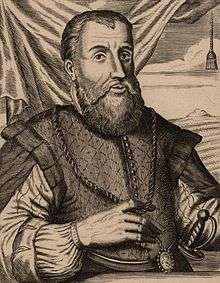Spanish immigration to Cuba
| Total population | |
|---|---|
|
(Total 4,000,000-10,000,000 Spanish residents 97,980 (2013) [1]) | |
| Regions with significant populations | |
| Languages | |
| Spanish | |
| Religion | |
|
Predominantly Roman Catholicism Large Protestantism minority | |
| Related ethnic groups | |
| Part of a series on |
| Spaniards |
|---|
| Regional groups |
Other groups |
| Diaspora |
| Languages |
|
Other languages
|
| Religion |
|
|
Spanish immigration to Cuba began in 1492, when Christopher Columbus first landed on the island, and continues to the present day. The first sighting of a Spanish boat approaching the island was on 27 or 28 October 1492, probably at Bariay on the eastern point of the island. Columbus, on his first voyage to the Americas, sailed south from what is now The Bahamas to explore the northeast coast of Cuba and the northern coast of Hispaniola. Columbus discovered the island believing it to be a peninsula of the Asian mainland.[2][3]
Early settlement

In 1511, Diego Velazquez set out with three ships and an army of 300 men from Hispaniola to form the first Spanish settlement in Cuba, with orders from Spain to conquer the island. The settlement was at Baracoa, but the new settlers were to be greeted with stiff resistance from the local Taíno population. The Taínos were initially organized by cacique (chieftain) Hatuey, who had himself relocated from Hispaniola to escape the brutalities of Spanish rule on that island. After a prolonged guerrilla campaign, Hatuey and successive chieftains were captured and burnt alive, and within three years the Spanish had gained control of the island. In 1514, a settlement was founded in what was to become Havana.
Historical influence
Language
Alondra
Spanish was brought to Cuba by the Spaniards and is the dialect of the Spanish language as it is spoken in Cuba. Cuban Spanish is most similar to, and originates largely from the Spanish spoken in the Canary Islands. Cuba owes much of its speech patterns to the heavy Canarian migrations, of the 19th and early 20th centuries.
Religion
Cuba is traditionally a Catholic country. The Roman Catholic religion was brought to Cuba by Spanish colonialists at the beginning of the 16th century, is the most prevalent professed faith. After the revolution, Cuba became an officially atheistic state and restricted religious practice. Since the Fourth Cuban Communist Party Congress in 1991, restrictions have been eased and, according to the National Catholic Observer, direct challenges by state institutions to the right to religion have all but disappeared,[4] though the church still faces restrictions of written and electronic communication, and can only accept donations from state-approved funding sources.[4] The Roman Catholic Church is made up of the Cuban Catholic Bishops' Conference (COCC), led by Jaime Lucas Ortega y Alamino, Cardinal Archbishop of Havana.
The Roman Catholic Church estimates that 60 percent of the population is Catholic. But the Catholic Church is subject to government restrictions, and it is not allowed to have its own schools or media.[5] According to statistics, Catholics represent 71.79% of Havana's population, 69.24% Matanzas, 63.15% Camagüey and Santiago de Cuba having the lowest percentage of Catholics at 23.81%.[6]

Bullfighting
Bullfighting as well as traditional cultural fiesta's, also saw a presence in Cuba during its colonial period uninterrupted from 1538 to 1899. In Havana there were many plaza de toros with many of the torero's coming from Cadiz, Spain. In the first half of the 19th century, bullfights were held in Sancti Spíritus in 1850 and other cities.[7] One of the most prominent bullfighters at the time was "Cheche de la Habana" José Marrero Báez (1870–1909) born in Havana, Cuba and died performing in Ciudad Jiménez, Mexico. In the 19th century, Havana and Montevideo were major bullfighting cities which eventually lost the tradition.[8]
Immigration waves
The European heritage of Cubans comes primarily from one source: the Spaniards (including Canarians, Asturians, Catalans, Galicians and Castilians). The native white population are nearly all descendants of the Spaniards and most non-white Cubans also have Spanish ancestry.[9]
Early 20th Century
Other results show that between 1902 and 1931, 780,400 (60.8%) were from Spain, 197,600 (15.4%) from Haiti, 115,600 (9.0%) from Jamaica and 190,300 (14.8%) other countries.[10]
Present situation
According to current statistics, there are over 9,566 Canarians, 23,185 Andalusians and 11,114 Galicians living in Cuba.[11][12]
See also
References
- ↑ "Explotación estadística del Padrón de Españoles Residentes en el Extranjero a 1 de enero de 2013" (PDF). INE. Retrieved 22 July 2013.
- ↑ Carla Rahn Phillips (1993). The Worlds of Christopher Columbus (reprint, illustrated ed.). Cambridge University Press. p. 205. ISBN 978-0-521-44652-5.
- ↑ Thomas Suarez (1999). Early Mapping of Southeast Asia. Tuttle Publishing. p. 109. ISBN 978-962-593-470-9.
- 1 2 Catholic church in Cuba strives to reestablish the faith National Catholic Observer
- ↑ "... the church would like the right to bring in more missionaries and perform works of charity without first seeking government approval. It would also like to open its own schools and have a voice in the state-controlled media." Cuba softens stance toward Catholic Church - World Blog - msnbc.com
- ↑ Catholic Population
- ↑ ¿Corridas de toros en Cuba? Bullfights in Cuba?
- ↑ TOROS EN CUBA (In Spanish)
- ↑ Spanish Emigration to Cuba
- ↑ Fazer a América: a imigração em massa para a América Latina By Boris Fausto
- ↑ How many Canarians in other countries.
- ↑ Censo electoral de galegos residentes no estranxeiro a 1 de abril de 2008, segundo país de residencia e provincia de inscrición